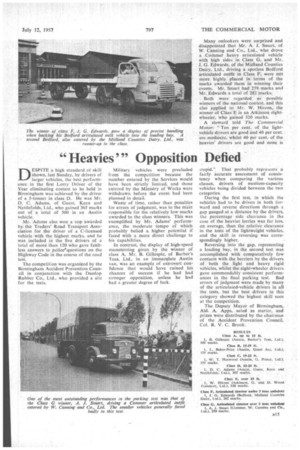" Heavies " Opposition Defied
Page 49

If you've noticed an error in this article please click here to report it so we can fix it.
DESPITE a high standard of skill shown, last Sunday, by drivers of larger vehicles, the best performance in the first Lorry Driver of the Year eliminating contest to be held in Birmingham was achieved by the driver of a 5-tonner in class .D. He was Mr. D. C. Adams, of Guest, Keen and Nettlefolds, Ltd-, who gained 365 marks out of a total of 509 in an Austin vehicle.
Mr. Adams also won a cup awarded by. the Traders' Road TranSport Association for the driver of a C-licensed vehicle with the highest marks, and be was included in the five drivers of a total of more than 120 Who gave faultless answers to policequestions on the Highway Code in the course of the road test.
The competition was organized by the Birmingham Accident Prevention Council •in conjunction with the Dunlop Rubber Co., Ltd., who provided a site for the tests. Military vehicles were precluded from the competition because the number entered by the Services would have been strictly limited, and those entered by the Ministry of Works were withdrawn before the event had been planned in detail.
Waste of time, rather than penalties for errors of judgment, was in the Main responsible for the relatively low marks awarded to the class winners. This was exemplified by Mr. Adams' performance, the Moderate tempo of which probably belied a higher potential if faced with a more direct challenge to his capabilities.
In contrast, the display of high-speed manceuvring given by the winner of class A, Mr. B. Gillespie, of Barber's Teas. Ltd., in an immaculate Austin van, was an example of extrovert confidence that would have ruined his chances of success if he had had stronger opposition, unless he had had a greater degree of luck.
Many onlookers were surprised and disappointed that Mr. A. J. Smart, of W. Canning and Co., Ltd„ who drove a .Commer heavy articulated vehicle with high sides in Class G, and Mr. J. G. Edwards, of the Midland Counties Dairy, Ltd., driving a spotless Bedford articulated outfit in Class F, were nt5t more highly placed in terms of the marks awarded them in winning their events. Mr. Smart had 259 marks and Mr. Edwards a total'of 282 marks.
Both were regarded as possible winners of the national contest, and this also applied to Mr. W. Hirons, the winner of Class E in an Atkinson eightwheeler, who gained 320 marks.
A steward told The Commercial Motor: "Ten per cent. of the lightvehicle drivers are good and 40 per cent. are mediocre, whilst 40 per cent of the heavies' drivers are good and none is stupid.", That probably represents a fairly accurate assessment of consistency when comparing the various classes, drivers of medium-capacity vehicles being divided between the two categories.
During the first test, in which the vehicles had to be driven in both forward and reverse directions through a gap gauged at a distance by the drivers, the percentage side clearance in the case of the heavier lorries was far less, on average, than the relative clearance in the tests of the lightweight vehicles, and the skill in reversing was correspondingly higher.
Reversing into the gap, representing a loading hay, in the second test was accomplished with comparatively few contacts with the barriers by the drivers of both the light and heavy rigid vehicles, whilst the eight-wheeler drivers gave commendably consistent performances in the final parking test. Bad errors of judgment were made. by many of the articulated-vehicle drivers in all the tests, but the best drivers in this category showed the highest skill seen at the competition.
The Deputy Mayor of Birmingham, Ald. A. Apps, acted as starter, and prizes were distributed by the chairman of the Accident Prevention Council, Col. R. V. C. Brook.




































































































